Marketers that use email marketing for lead nurturing are a great deal more successful in converting leads into paying customers. With nurturing, you can gradually groom and prepare prospects to view your brand positively.
It helps you engage with your prospects and stay in touch meaningfully. That means when the prospect is ready to make their next purchase, your brand is right at the top of their mind.
What is lead nurturing email
A lead nurturing email is an email sent to move prospects one step closer to conversion in your sales funnel.
Lead nurturing emails are a part of an email marketing campaign sent to prospects during various stages of the buyer journey, in order to positively influence their buying behaviour. This is achieved by educating prospects, explaining solution features, furnishing use cases, and building a relationship with them.
Each email in the lead nurturing campaign is personalized using research and analytics, making them more engaging and contextual. These emails are automated into a drip sequence, using email automation technology. The customized yet automated nature of such emails make them both effective and efficient.
Why use email for lead nurturing
Emails are great for lead nurturing because they can be personalized, they allow you the undivided attention of your prospects, and they provide you incremental scope for engagement.
Sure, you may use social media platforms like Twitter or Instagram when you’re carrying out brand-building exercises. But these platforms come with their own limitations:
- There’s too much distraction for a prospect to really focus and make a purchase.
- You can’t personalize your message.
- The analytics available are rather limited.
- They are, after all, third-party platforms, so you have only a limited control.
All this makes lead nurturing emails key to successful conversion.
Why lead nurturing is important
Lead nurturing is important to sustain your prospect’s interest, enrich your relationship with them and eventually make them trust you to solve their problem. By cultivating your relationship with your prospects and nurturing leads, you can shorten the sales cycle.
That’s because it’s rare for your website visitors to make a purchase on the first visit. Here’s a few reasons why:
- They’re checking other alternatives too.
- There’s a team of people who’ll be involved in the purchase decision.
- You haven’t been able to build enough trust.
- They’re short of time currently and will return to decide.
- They aren’t sure what a few terms on your page mean so they need to check with their teams.
- They’re not ready for a purchase yet anyway.
- The bigger the price tag of your solution, the longer the sales cycle. A $3 brooch can be an impulse buy, a piece of $12,000 software can’t.
This makes it important that you engage them over a series of emails. Using a strong lead nurturing strategy, you can firmly establish your capability to overcome whatever your prospects’ challenges.
Yes, knowing how to write a great email is useful, but there’s more. You need to carefully guide prospects along their journey as they explore, understand, and trust your brand and, ultimately, make a purchase.
Lead nurturing with email marketing automation helps your brand stay in touch with your prospects on a regular basis. It makes sure your emails steadily boost the faith prospects have in your brand as far as solving their problems is concerned.
Lead nurturing strategies, right from your welcome email, should be directed to constantly move the prospect to the next stage of your sales funnel.
10 steps of email marketing for lead nurturing
We will begin with an infographic that summarizes the ten steps of lead nurturing practices and strategies:
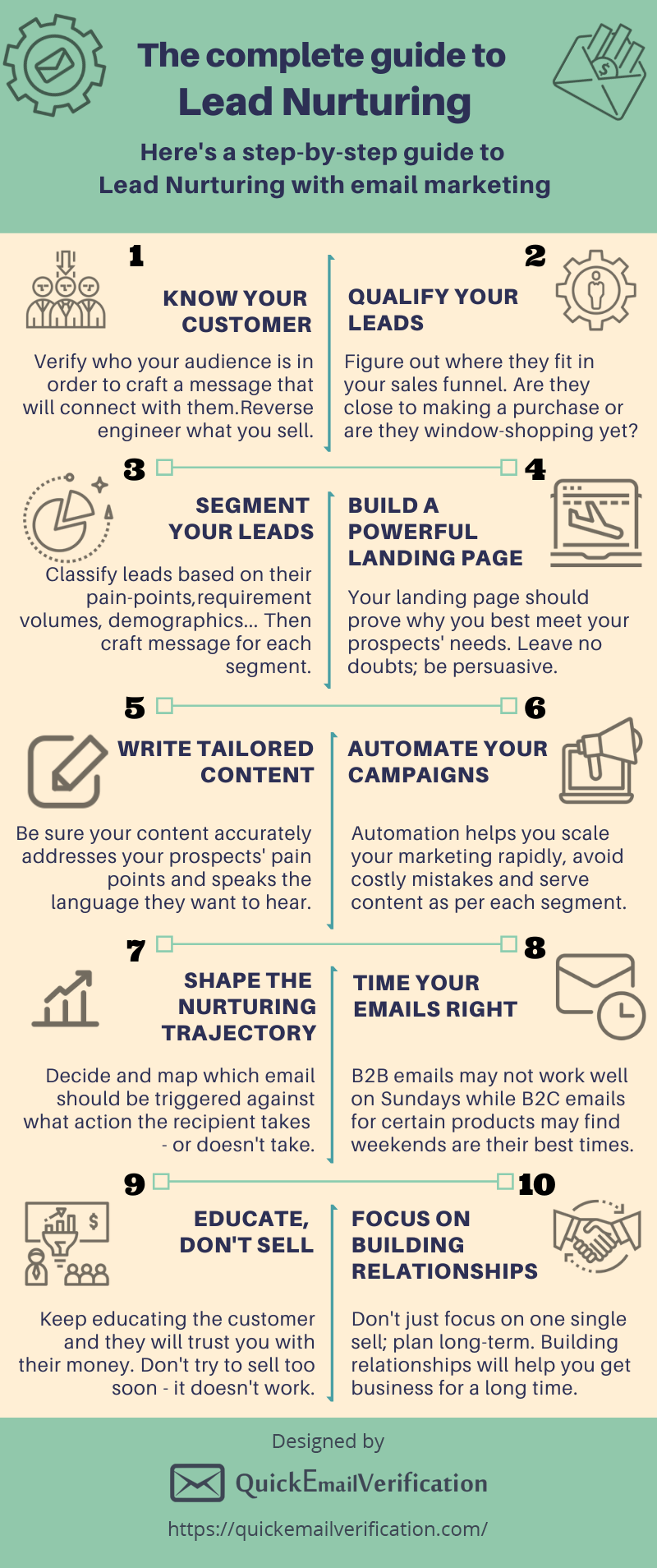
Here’s a step-by-step explanation of lead nurturing with email marketing.
1. Know your customer
All effective lead nurturing strategies begin with knowing your customer. Verify who your audience is in order to craft a message that will connect with them.
Knowing your customer accurately takes a little time. Don’t be discouraged if your message falls on deaf ears at the start. It’s easy to mistakenly package a product with the assumption that it will be suitable for anyone who buys it.
For many businesses, reverse engineering what they sell often helps understand their customers. For others, it’s easier to profile actual customers and draw out a common denominator. Generally, it’s a good idea to begin with an approximate profile and then continue tweaking it as you receive further data.
You’ll waste time and money if your strategy is to nurture the entire world into buying what you sell. For example, someone who needs a prom outfit is preparing for the prom, so a consumer travelling to attend a business meeting won’t be an ideal target to sell to.
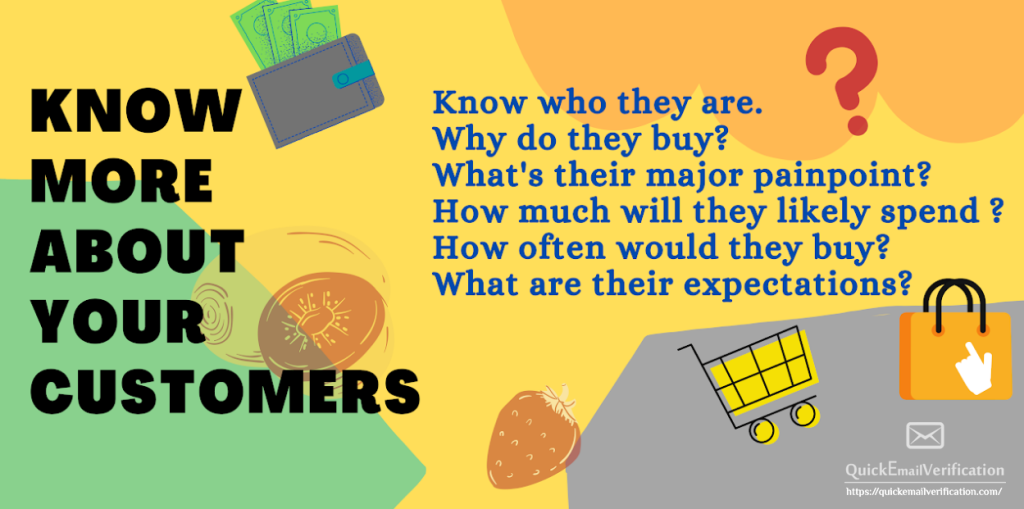
2. Use lead qualification
Lead qualification is the process of figuring out the chances of a lead turning into a customer. This process works in sync with the process of knowing your ideal customer. That’s because the closer a lead is to your ideal customer profile (ICP), the higher the chances of conversion.
Lead qualification tells you if a lead is worth all the energy, time and resources you normally invest in taking leads through various stages until they become your customer.
A set of the three questions below are a good place to start:
- What’s the most likely benefit vs cost ratio from the POV of the prospect if they were to make a purchase?
- Does the prospect have the capacity to pay for what you’re trying to sell to them?
- What’s our best estimate about the time over which the prospect is most likely to make a purchase?
Items like gated content can give you additional insights into your lead qualification system; people who offer their email in exchange for an ebook, for instance, are more likely to be interested in your solution. That way, you know you’re spending your lead nurturing resources on the right prospects.
3. Segment your leads
Just like you can reap the true benefits of an email list only after email list segmentation, you can get more out of your leads only when you segment your leads.
In order for your marketing and sales to be successful, lead nurturing strategies should focus on personalizing your communications. Whatever you know about your leads can help to tailor specific emails to specific leads.
Dive deeper into recipient demographics and group them on the basis of shared criteria. Then identify the pain-point of each group and serve appropriate content.
Let’s say you sell shoes. Your 22-year old customer who’s training for athletics will be looking for better speed while your 64-year old customer would be looking for better grip and stability. No way you can keep both of them happy with the same email.
Sending content that’s appropriate for the segment, apart from making more sense for sales, also shows you care for your recipients’ time. That keeps them from marking your emails as Spam.
.
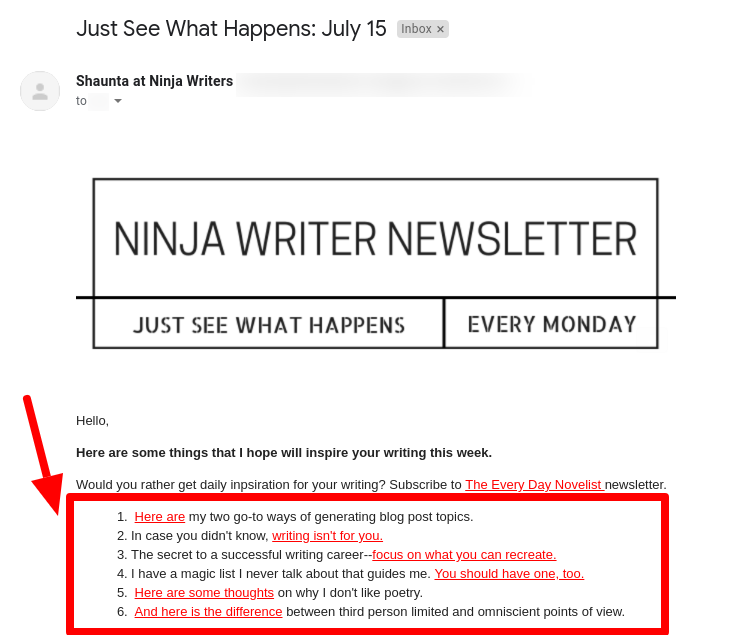
In the image above, the marketer can begin figuring out what would interest the subscriber, based on which link the subscriber clicks (and spends the most time on). (Source: Shaunta Grimes Ninja Writer).
4. Build a powerful landing page
Some businesses often miss optimising their landing pages, forgetting how important they are in the lead nurturing funnel. Because landing pages are key in encouraging prospects to take action, they are very important marketing assets.
A landing page should focus on the visitor and help them clearly see why you’re the right solution for their challenges. Many successful landing pages use some variation of the PAS model: Problem, Agitate, Solution. You state the problem, you agitate it and highlight the damage it causes to your prospect, and finally offer your solution.
Finally, there’s an important element: design consistency. Your emails should follow the design of your landing pages. The resemblance should be strong enough or the visitor might feel they’ve landed on the wrong page – and quickly exit the landing page.
Check the example below. The image on the left is that of the email, while the image on the right is that of the landing page. You’ll notice the design and layout of the box is identical. (Image: PublisherRocket)

5. Write tailored content
In some ways, this is the tipping point of your lead nurturing campaign. Good, compelling content will hugely improve engagement and your overall relationship with the leads you are trying to win over. Choppy, poorly crafted content will alienate your leads, probably forever.
While there’s no fool-proof recipe you can use to craft killer content, there are some points that make sure you remain on the right track. Here’s a quick guide on how to write powerful lead nurturing emails:
- Start with Pain: Use “pain” to connect with your leads by highlighting the struggles they have. Give them a reason to believe that they’re not alone and that they urgently need a solution.
- Build Scarcity: Rub “that pain” in. Delay the revelation, which is the solution that you’re about to unfold. Simply give them more reasons to see why they need your product.
- Reveal the Benefits and Features: Now give your readers a look into the product’s features and benefits. Benefits are the positive results of using a product.
- Prove It: Now give your readers an example of someone benefiting from the product that you’re showcasing. You can use testimonials or create a public display where people can put your product to use.
- Make a Final CTA: Now, get straight to the point. Ask them to buy, to sign up or to visit another piece of content. Your entire content strategy should be built around this “call to action.” However, that CTA should never be revealed unless you have nurtured your leads.
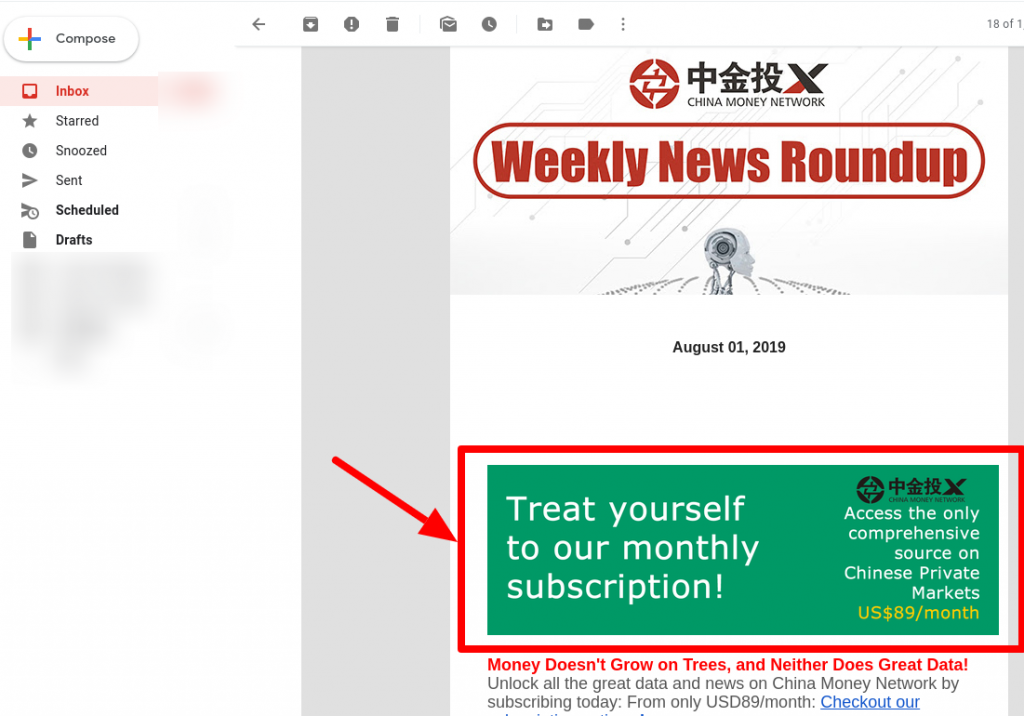
The above image has a clear CTA: the sender is asking you to subscribe. Notice the clean design and how the CTA is visually separated from everything else.
6. Automate your campaigns
An effective lead nurturing email campaign can scale up only with automation. Email automation can help you scale trigger emails, based on what actions your prospects take. That makes your prospects feel you’ve personalized your message to them.
Email automation goes beyond allowing you to set a send time for the emails – there’s a lot more.
It will enable you to observe and understand your prospects’ behavior closely: who opens your emails, who clicks where you want them to, how they behave once they arrive on your landing page and so on.
This takes you to the next step: shaping the nurturing trajectory for each prospect.
7. Shape the nurturing trajectory
Nurturing your leads means basing your emails on the customer journey. A prospect who downloads a PDF receives a different message (“Thank you! Here’s how you can make the best of this PDF….”) and a prospect who doesn’t download the PDF will receive a different message (“Check out this ebook to learn how Company X saves 12% in their energy costs…”).
Based on all the insights you receive from your prospects’ behavior, you can schedule subsequent emails and also improve your content as well as design. The right analysis of insights can hugely improve your lead scoring, or estimating how worthy the prospect is.
One of the biggest benefits of lead nurturing using emails is that you can fully customize the way each prospect engages with your brand. This otherwise complex and huge task becomes simple only because of email automation.
8. Time your emails right
It would do your brand no good if a perfectly designed email were to reach your prospect at the wrong time. It could go unnoticed and remain buried among other emails clamoring for attention – never to be read.
Which is why timing your emails should have an important place in your lead nurturing strategies. Depending upon the geographical location of your lead, the nature of your product (B2B vs B2C) and so on, keep experimenting till you find the sweet spot.
Consider these two different situations:
- You’re a B2B business, selling industrial fasteners. It’s strictly a business email and you don’t want to disturb your prospects on weekends when they’re away from work. If you do, your email might annoy them or simply be overlooked when they open their mail-box on Monday.
- You’re a B2C business. You sell coloring books for kids. Your target group is parents who want to buy them for their kids. Perhaps a weekend email is the best way to get the parents’ attention might be Sunday, when it’s out and out family time.
Some studies (Source) suggest Tuesdays and Thursdays are the best days to send emails. See if that’s true for your emails too.
Scheduling your emails at the right times can have a positive cascading effect. The right time gets you better open rates. This in turn, improves your chances of better CTRs. Better CTRs get your better conversions.
Simultaneously, better open rates improve your sender reputation and inbox placement.
9. Educate, don’t sell
One of the most delicate balancing acts in creating content for lead nurture emails is how to steer clear of hard-selling without sacrificing the overall goals of revenue.
There are two principal reasons why your nurturing emails for a lead campaign should educate rather than sell. One, these are not sales emails that you typically send out to someone who has made an inquiry about your product. And two, your prospects, in all likelihood, signed up to learn something and not to hear your sales pitch.
Here’s an excellent example. See how the email only offers to help teach drawing stick figures, without any attempt to sell a course.(Source: Alison Beere)
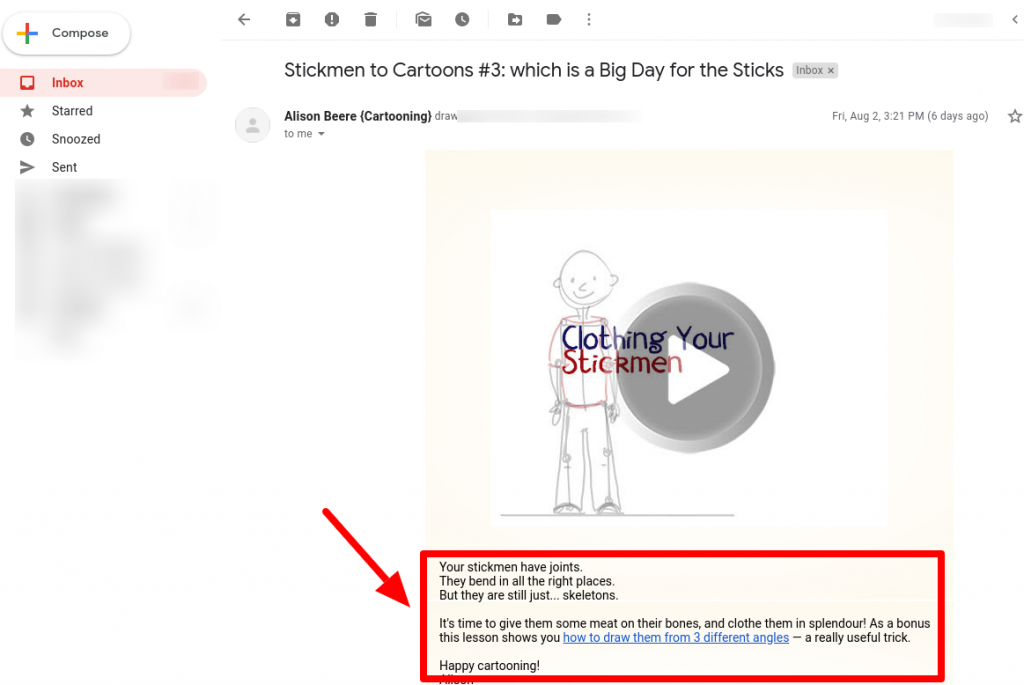
10. Focus on building relationships
‘All things being equal, people will do business with a friend; all things being unequal, people will still do business with a friend.’ When Mark McCormack, sports agent and founder of the IMG, made this remark at least three decades back, the world of selling was vastly different.
Today, selling has changed very much. But McCormack’s words are as true today as they were back then. Relationships matter in face-to-face sales; relationships matter in the virtual world as well.
When you’re trying to nurture leads through email, your relationship starts at a fragile base. The harsh reality is that your subscribers think of you as just another marketer who’s keen to make a sale. It’s your job to change that perception by building a stronger relationship.
Your relationship with your subscribers rests on three pillars:
- your communication quality,
- your ability to exceed expectations, and
- your willingness to solve their problems without hurrying into making a sale.
Invite and respond to feedback from subscribers, be appreciative of their inputs and respect them by sending out only helpful, quality content. Take care of relationships and soon your sales will begin to take care of themselves.
.

The above image (Source: AWeber) shows the marketer’s willingness to begin a dialogue and offer help. That’s a great way to begin a relationship.
Lead nurturing statistics
The following infographic on lead nurturing statistics will further emphasise the importance of nurturing leads:
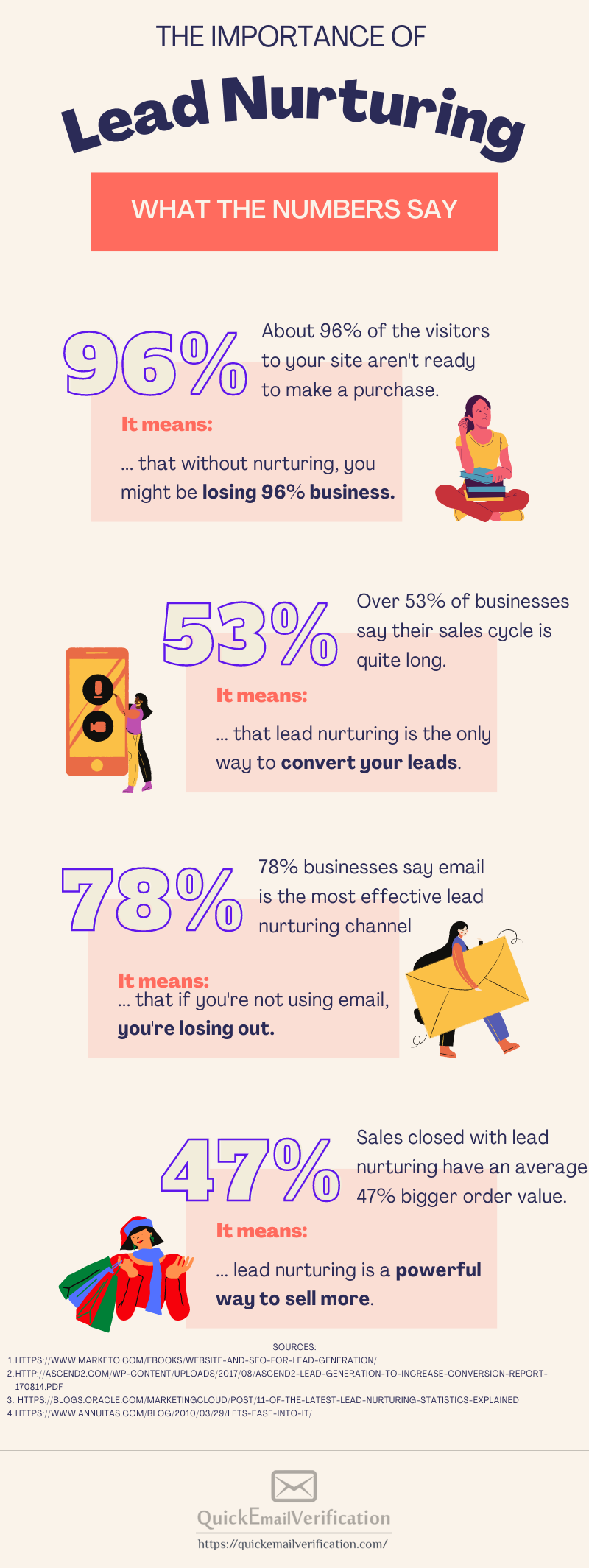
From the statistics above, it’s clear that:
- If you know how to nurture leads, a great deal more visitors to your website than before will buy.
- A lot of your deals happen over time, so make sure you run multi-channel lead nurturing strategies. That way, no matter what platform your prospects are active on, you’re there too,
- Lead nurturing with email is a proven system. If you aren’t using it, it’s high time you began.
- Keep exploring different ways to nurture leads, because when you improve your lead nurturing strategy, you also get a bigger volume of business from the same prospects.
Final words
Using emails to nurture leads is one of the most cost-effective ways of building your sales pipelines.
At the same time, nurturing leads is a medium- to long-term investment. That’s why you can’t expect your third email to set your cash registers ringing.
Following lead nurturing best practices makes the entire process efficient and productive. Listen to your subscribers, offer helpful stuff and use email marketing automation to develop customized lead nurturing campaigns.

